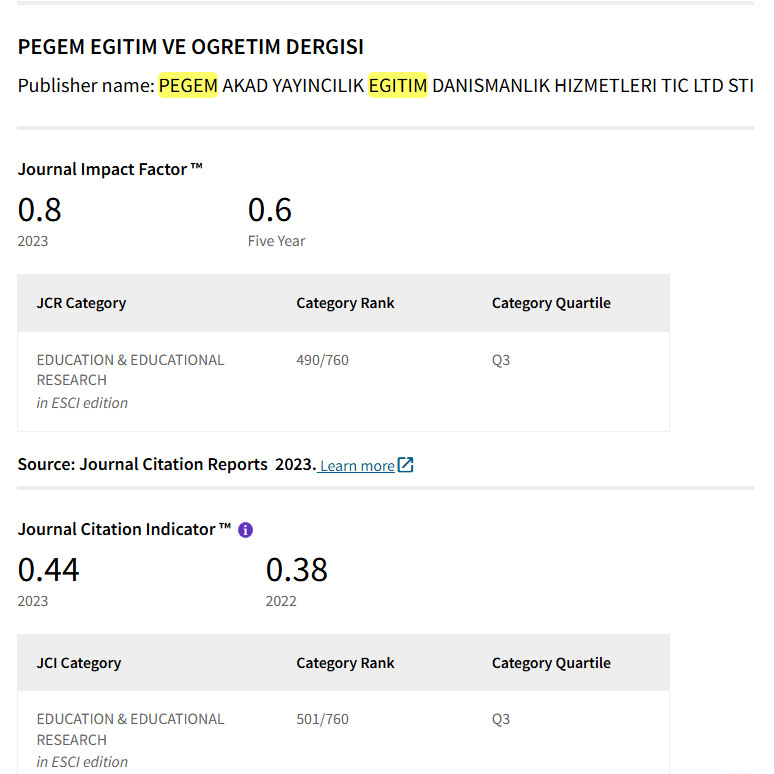The Use Of Instagram Media Is Integrated With The Inquiry Learning Model To Improve Critical Thinking Skills And Student Learning Motivation In The Matter Of Reaction Rates
DOI:
https://doi.org/10.47750/pegegog.14.02.18Keywords:
learning motivation, critical thinking, reaction rate, inquiry, InstagramAbstract
The aim of this study was to see the effect of using the Instagram media-integrated inquiry learning model in increasing learning motivation and students' critical thinking skills in the matter of reaction rates. This research is a Quasi Experimental Design type. Population consist of class XI MIPA students of SMAN 1 Turen. Sampling used the Simple Random Sampling technique and it was found that there were 32 students in class XI MIPA 4 as the sample for the class of experimental and for class XI MIPA 5 with 32 students as the sample for the class of control. Data analysis used qualitative and quantitative descriptive tests with independent sample-t tests and N-Gain. Qualitative analysis showed an increase in learning motivation in the class of experimental (74%) higher than the class of control (64%). Statistical analysis showed that there were significant differences in students' critical thinking skills with sig. (2-tailed) 0.000 < 0.05. The N-Gain test showed an increase in the critical thinking skills of the class of experimental (0.82) higher than the class of control (0.72). The results of this analysis indicate that the inquiry learning model integrated with Instagram media is able to increase learning motivation and students' critical thinking skills in the material of reaction rate
Downloads
References
Amnawati, B. (2022). Upaya Meningkatkan Motivasi Belajar Peserta Didik Di KElas X TPP PAda MAteri Pergerakan Nasional Dengan Memanfaatkan Instagram. EDUCATOR : Jurnal Inovasi Tenaga Pendidik dan Kependidikan, 2(1), 72–83. https://doi.org/10.51878/educator.v2i1.1095
Ariza Rahmadana Hidayati, Wirawan Fadly, & Rahmi Faradisya Ekapti. (2021). Analisis Keterampilan Berpikir Kritis Siswa pada Pembelajaran IPA Materi Bioteknologi. Jurnal Tadris IPA Indonesia, 1(1), 34–48. https://doi.org/10.21154/jtii.v1i1.68
Facione, P. A. (2015). Critical Thinking: What It Is and Why It Counts. Critical Thinking, 1–30.
Firdausy, S., Rokhim, D. A., & Widarti, H. R. (2020). Application of Contextual Teaching And Learning (CTL) Model to Improve Learning Outcomes and Critical Thinking Ability in Redox and Electrochemical Material for Class XII SMA. Jurnal Pendidikan Dan Pembelajaran Kimia, 9(3), 79–93. https://doi.org/10.23960/jppk.v9.i3.202008
Mukmainah, S. A. (2020). Penerapan Model Pembelajaran Inkuiri Terbimbing Untuk Meningkatkan Keterampilan Berpikir Kritis Peserta Didik Pada Materi Laju Reaksi Di SMAN 1 Rengel. Journal of Chemistry Education, 9(1), 133–139.
Mustaricha, M. (2019). Efektivitas Model Pembelajaran Inkuiri Dalam Meningkatkan Kemampuan Berpikir Kritis Siswa Pada Mata Pelajaran Pendidikan Pancasila Dan Kewarganegaraan. Jurnal Ilmiah Pendidikan Pancasila dan Kewarganegaraan, 4(2), 368–373. http://journal2.um.ac.id/index.php/jppk
Peraturan Menteri Pendidikan Nasional No. 26. (2006). Peraturan Menteri Pendidikan Nasional Republik Indonesia Nomor 23 Tentang Standar Kompetensi Lulusan Untuk Satuan Pendidikan Dasar Dan Menengah.
Prasetiyo, M. B., & Rosy, B. (2020). Model Pembelajaran Inkuiri Sebagai Strategi Mengembangkan Kemampuan Berpikir Kritis Siswa. Jurnal Pendidikan Administrasi Perkantoran (JPAP), 9(1), 109–120. https://doi.org/10.26740/jpap.v9n1.p109-120
Rachmawati, D., & Rohaeti, E. (2018). Pengaruh Model Pembelajaran Sains, Teknologi, dan Masyarakat Terhadap Kemampuan Berpikir Kritis dan Motivasi Belajar Peserta Didik. Jurnal Pendidikan Matematika dan Sains, 6(1), 29–39. http://journal.uny.ac.id/index.php/jpms
Rohim, Ali Muhammad, Y., Dwi & Yulianti, Dwi. (2020). Unnes Physics Education Journal. Unnes Physics Education Journal, 9(2), 149–157. http://journal.unnes.ac.id/sju/index.php/upej
Rokhim, D. A., Widarti, H. R., & Fajaroh, F. (2020). Pengembangan Bahan Belajar Flipbook Pada Materi Redoks dan Elektrokimia Berbasis Pendekatan STEM-PjBL Berbantuan Vidio Pembelajaran. Kwangsan: Jurnal Teknologi Pendidikan, 8(2), 234. https://doi.org/10.31800/jtp.kw.v8n2.p234--250
Rosmanah, Y. (2021). Peningkatan Motivasi Belajar Bahasa Inggris Materi Caption Menggunakan Media Instagram Siswa Kelas XII IPA 4 SMA NEGERI 1 Dawarblandong Mojokerto Tahun Pelajaran 2020/2021. Jurnal Inovasi Pendidikan Bahasa dan Sastra, 1(1), 43–50. https://doi.org/10.51878/language.v1i1.379
Salamudin, C., & Amelia, E. M. (2022). Pengaruh Penerapan Model Pembelajaran Inkuiri Sosial Pada Mata Pelajaran Pendidikan Agama Islam Terhadap Kemampuan Berpikir Kritis Siswa Di SMAN 14 Garut. Jurnal Masagi, 01(01), 1–7. www.journal.stai-musaddadiyah.ac.id
Seran, M. V. L., Ain, N., & Sundaygara, C. (2019). Pengaruh Model Pembelajaran Inkuiri Terbimbing terhadap Motivasi Belajar dan Kemampuan Berpikir Kritis Siswa SMPN 02 Wagir. Seminar Nasional FST, 2, 439–446.
Suarsini, N., Wesnawa, I., & Kertih, I. (2020). Pengembangan Media Pembelajaran Geografi Berbasis Media Sosial Instagram untuk Peningkatan Motivasi dan Hasil Belajar Siswa. Jurnal Pendidikan IPS Indonesia, 4(2), 72–81. https://doi.org/10.23887/pips.v4i2.3386
Widiasrumana, H. C. (2017). Penerapan Metode Eksperimen Untuk Meningkatkan Motivasi Belajar, Nilai Karakter, Dan Pengetahuan Siswa Kelas VIII SMP Negeri 6 Wonogiri Pada Materi Gaya Gesek. UNIVERSITAS SANATA DHARMA.
Widyasari, S. F., Masykur, R., & Sugiharta, I. (2021). Flipped Classroom: Peningkatan Kemampuan Berpikir Kritis Matematis Dan Motivasi Belajar Peserta Didik Madrasah. Journal of Mathematics Education and Science, 4(1), 15–22. https://doi.org/10.32665/james.v4i1.171
Wijaya, T. (2022). Efektivitas Strategi Inkuiri Dalam Meningkatkan Kemampuan Berpikir Kritis dan Motivasi Belajar Siswa Pada Pembelajaran Tematik KElas IV MI Sunan Kalijogo Karangbesuki Malang. Universitas Islam Negeri Maulana Malik Ibrahim Malang.
Downloads
Published
How to Cite
Issue
Section
License
Copyright (c) 2023 Pegem Journal of Education and Instruction

This work is licensed under a Creative Commons Attribution-NonCommercial 4.0 International License.
Attribution — You must give appropriate credit, provide a link to the license, and indicate if changes were made. You may do so in any reasonable manner, but not in any way that suggests the licensor endorses you or your use.
NonCommercial — You may not use the material for commercial purposes.
No additional restrictions — You may not apply legal terms or technological measures that legally restrict others from doing anything the license permits.



